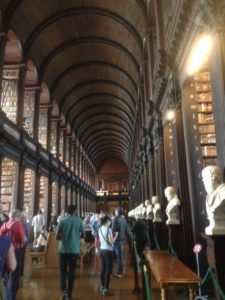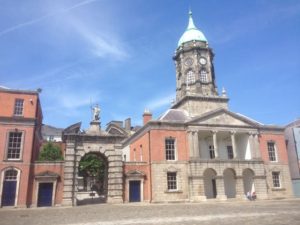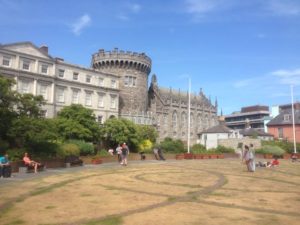A shuttle bus from the port to the town center costs 15 E each, but sounds like a convenience. We don’t land until 11am so the 10:30 walking tour won’t be possible. Debarkation is a bit late, so we don’t get to Dublin town center until a bit before noon. We hoof it to Trinity College and stand in line for the Book of Kells exhibit for about 30 min.
The book of Kells is an illuminated version of the four Gospels that was created around 800 AD.
The Long Room Library holds 2000 books arranged not by topic but by size. It is lined with bust of the great thinkers.
Afterward, we tried to grab a bite to eat in a pub across from Trinity before our 2pm Sandeman’s walking tour from the park next to the old Dublin City Hall, but there wasn’t time, so we grabbed a sandwich and ate as we walked. A friendly Irishman stopped on his bike and asked where we wanted to go when he saw us looking at our map.
We had time to grab a pint of Guinness before the tour started. Patrick, our tall, blond guide from Kinsale, was excellent.
 I would recommend this tour as heartily as the one in Cork. Although it was larger, Patrick was as informative and entertaining as Jack in Cork. He gave us a quick history of the portal tombs and passage tombs (like Newgrange) built by neolithic peoples in Ireland, and he taught us several Irish expressions.
I would recommend this tour as heartily as the one in Cork. Although it was larger, Patrick was as informative and entertaining as Jack in Cork. He gave us a quick history of the portal tombs and passage tombs (like Newgrange) built by neolithic peoples in Ireland, and he taught us several Irish expressions.
The Celts arrived in Ireland from Europe around 500 BC bringing with them the Iron Age. Christianity was introduced by St. Patrick, who in 389 was kidnapped from England by Irish pirates and sold into slavery. He escaped and sailed back to England only to receive a vision from God that he needed to return to Christianize the Irish.
Around 500 AD was the golden age of monasteries. The Vikings began raiding the monasteries in the 6th ad 7th centuries, and founded Dublin, which comes from the Viking words for dark water. In 1170 the Anglo Normans invaded but intermarried with the Celts to become Celtic Normans.
It wasn’t until 1150 when Henry VIII divorced the Pope and introduced Protestantism that the real trouble started. Ireland became a plantation for Protestant immigrants from England and Scotland. The Irish rebelled time and again, allying themselves with whoever was England’s enemy.
Hugh the Red was the son of one of two powerful Celtic clans, the O’Neils and the O’Donahues. He was kidnapped through a promise of free wine and imprisoned for 5 years in the gaol of Dublin Castle. When he escaped, his father made him leader, and he declared war on the British and allied himself with the Spanish who sent the Spanish Armada to help the Irish fight the British, but the fleet were thrown off course by storms and ended up in Kinsale instead of Donegal where they were defeated by the English even though the Irish marched from Donegal to join them.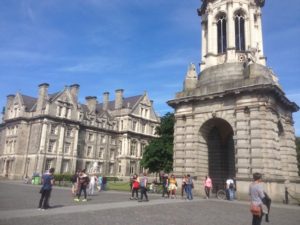
Patrick told anecdotes about the 1916 uprising, in which the Irish were helped by the Germans, who England was at war with. The Germans sailed a boat to Ireland with a guns and amo but the Irish were late to meet it and the Germans sunk the boat in order not to be taken by the British. The rebels decided to go ahead with the rebellion and 19 men and women stormed Dublin Castle, taking it easily because the British had intelligence that they would attack a day earlier, and as a result, believing the danger was past, had sent the soldiers to the races. The Irish abandoned the Castle believing it was a trap and took over City Hall which they only managed to hold for 24 hours. When the British arrested and executed the leaders of the rebellion, the protest spurred the revolution.
We walked through a narrow alley where Jonathan Swift was born.
Christ Church, 1870, the oldest church in Dublin (protestant) was abandoned for years and used as a bar, distillery and brothel but a wealthy Dubliner whose money was from whiskey gave money for its restoration. St. Patricks Cathedral was restored with Guinness money, so they say they have a whiskey and a beer church.
The Temple Bar area is the old section with cobbled streets and lots of restaurants and pubs. 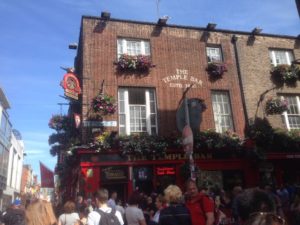
We ended the tour at Trinity College, established by Queen Elizabeth I to educate young Protestants. Catholics were not allowed to be educated.
We learned the Irish expression Craic (pronounced crack), which means fun.





